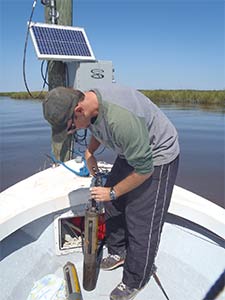ACE Basin/NERR Studies
Systemwide Monitoring Programs
 The first two ACE Basin SWMP stations began operation in 1995. Since then additional stations have come online so that today six water quality monitoring stations are operated. This long-term monitoring of abiotic environmental conditions includes weather, water quality parameters, and nutrient concentrations. Datasets from all of the reserves are archived, managed, and made available online by the NERRS Centralized Data Management Office (CDMO) for a variety of audiences including academic researchers, coastal managers, teachers and their students, and the general public. Weather, water quality, and nutrient data collected at the reserves are available for public viewing and downloading.
The first two ACE Basin SWMP stations began operation in 1995. Since then additional stations have come online so that today six water quality monitoring stations are operated. This long-term monitoring of abiotic environmental conditions includes weather, water quality parameters, and nutrient concentrations. Datasets from all of the reserves are archived, managed, and made available online by the NERRS Centralized Data Management Office (CDMO) for a variety of audiences including academic researchers, coastal managers, teachers and their students, and the general public. Weather, water quality, and nutrient data collected at the reserves are available for public viewing and downloading.
Weather is monitored using a Campbell Scientific® weather station located in the heart of the Reserve at the Bennett's Point Michael D. McKenzie Field Station. Weather parameters measured include air temperature, precipitation, relative humidity, barometric pressure, wind direction, wind speed, and photosynthetically active radiation (PAR). Real time data from the weather station can be viewed.
 Water quality is monitored at six sites distributed along a salinity gradient. A major focus for the ACE Basin Research Sector is monitoring the freshwater/saltwater dynamics of the South Edisto River. From highest salinity to lowest salinity, the sites are: Big Bay Creek, St. Pierre Creek, Mosquito Creek, South Edisto-Jehossee Island, Fishing Creek, and South Edisto-The Grove. Water quality parameters are measured using YSI® data loggers that record measurements continuously every 15 minutes. The parameters measured include water temperature, specific conductivity, salinity, pH, dissolved oxygen, turbidity, and depth (tidal cycle). Real time water quality data from the St. Pierre and Fishing Creek stations can be viewed. Nutrient concentrations (chlorophyll a, ammonia, nitrate + nitrite, dissolved inorganic nitrogen, and orthophosphate) are measured from monthly water grabs at the six water quality sites. In addition to the monthly monitoring, nutrient changes over tidal cycles are measure once a month at the St. Pierre Creek site using an ISCO® water sampler. The ISCO® collects a water sample every 2 hours and 4 minutes over a complete tidal cycle or lunar day (24 hours and 48 minutes).
Water quality is monitored at six sites distributed along a salinity gradient. A major focus for the ACE Basin Research Sector is monitoring the freshwater/saltwater dynamics of the South Edisto River. From highest salinity to lowest salinity, the sites are: Big Bay Creek, St. Pierre Creek, Mosquito Creek, South Edisto-Jehossee Island, Fishing Creek, and South Edisto-The Grove. Water quality parameters are measured using YSI® data loggers that record measurements continuously every 15 minutes. The parameters measured include water temperature, specific conductivity, salinity, pH, dissolved oxygen, turbidity, and depth (tidal cycle). Real time water quality data from the St. Pierre and Fishing Creek stations can be viewed. Nutrient concentrations (chlorophyll a, ammonia, nitrate + nitrite, dissolved inorganic nitrogen, and orthophosphate) are measured from monthly water grabs at the six water quality sites. In addition to the monthly monitoring, nutrient changes over tidal cycles are measure once a month at the St. Pierre Creek site using an ISCO® water sampler. The ISCO® collects a water sample every 2 hours and 4 minutes over a complete tidal cycle or lunar day (24 hours and 48 minutes).
